Delhi unveils Heat Action Plan ‘25 with 3,000 water coolers, shaded walkways

New Delhi: In a landmark step towards climate adaptation, Delhi Chief Minister Rekha Gupta on Monday launched the “Delhi Heat Action Plan 2025,” aiming to shield citizens from the intensifying threat of heatwaves. The plan, formulated under the guidance of the National Disaster Management Authority (NDMA), emphasises preparedness across sectors, from slum clusters to hospitals, schools, and public transport hubs.
Addressing an event at the Delhi Secretariat, CM Rekha Gupta said, “This plan has been prepared in a scientific and citizen-centric approach to protect Delhi citizens from extreme heat and dangerous heatwave conditions.” She emphasised that Delhi’s summers have begun to touch 50°C in recent years, turning heatwaves into a “deadly crisis”.
Key initiatives announced include the installation of 3,000 water coolers citywide, cooling shades on footpaths, and the implementation of cool roof and green roof technologies across government and private buildings. “We will ensure that every citizen and pedestrian in Delhi has access to clean and cold drinking water during summer,” the CM stated.
The plan also involves the launch of ‘Digital Cold Water Dispensers’ at public locations, and a pilot rollout of cool roof technology. “These are not just infrastructure upgrades, but a testament to the government’s commitment to environmental innovation,” said the Chief Minister.
Special heatwave wards are being established in major hospitals, equipped with cooling facilities, ORS, and trained staff. Over 1.4 million students across 5,500 schools will be trained in disaster management and heatwave preparedness through initiatives such as the ‘Water Bell’ campaign, encouraging regular hydration.
The Delhi Government will collaborate with the Indian Meteorological Department to issue color-coded heat alerts, green, yellow, orange, and red, and take action accordingly. Mobile alerts, media, and digital portals will aid in timely information dissemination.
“This is not just a government scheme, but a people’s movement,” declared CM Gupta, appealing for citizen involvement. “Until every citizen of Delhi participates in this effort, this seasonal challenge cannot be fully overcome.”
With support from agencies like UNEP, UNICEF, Resilience AI, and UC Berkeley, the plan includes district-level vulnerability mapping and tailored interventions for vulnerable groups, children, the elderly, outdoor workers, women, and those with chronic conditions.
Cold water facilities are also being arranged at bus stops and railway stations, while shelters and assistance centers will be set up in slum areas. The CM also stressed the need for compassion towards animals and birds, ensuring drinking water and shade are provided for them.
In her concluding remarks, the Chief Minister underlined the role of ‘Aapda Mitra’ disaster volunteers as “a living symbol of our vigilance and service spirit”. Referring to national campaigns like “Mission LIFE” and “Jal Jeevan Mission”, she added, “This is a collective resolve of Delhi’s citizens and the Government. A people’s movement to keep Delhi safe and protect the future of the coming generations.”
With an integrated and community-driven strategy, the Delhi Government aims to lead the way in urban climate resilience this summer.



